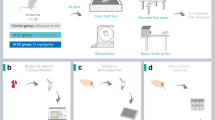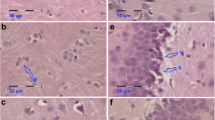Abstract
This study aimed to evaluate the effect of daily sublethal doses of aluminum (Al) on hematological, physiological, biochemical, and behavioral changes in male albino Wistar rats. In addition, Al tissue accumulation and histopathological changes in the cerebral cortex, liver, and kidney were examined. The rats were randomly separated into three groups. Group 1 included rats who received the median deadly dose (LD50) of aluminum chloride (AlCl3), group 2 served as the control, and group 3 was treated with a non-lethal dose of AlCl3 (1.5 mg/kg) intraperitoneally for 45 days. At defined time intervals, hepatic and renal specific enzymes and biochemical activity were measured. In addition, we examined Al accumulation, the condition of the liver via histological methods, and the impact on the cerebral cortex. In comparison to the controls, rats treated with AlCl3 exhibited a rise in AST, ALT, and ALP enzyme activity. We also saw a significant decrease in body weight and a decrease in total protein, lipids, cholesterol, acetylcholinesterase (AChE), RBCs, and Hb levels compared to the control group. Histopathological examination suggested severe changes in the liver, kidney, and cerebral cortex of the rats. The current study indicates that sublethal daily exposure to AlCl3 causes hazardous effects, as increased Al concentration in the body is shown to induce detrimental biochemical and histological changes as well as decreased body weight. Therefore, careful attention should be given to treatments requiring long exposure in patients and the potential for accumulation via food and drinking.





Similar content being viewed by others
References
Ali AA, Abd El-Latif DM, Gad AM, Elnahas YMA (2018) Nephrotoxicity and hepatotoxicity induced by chronic aluminum exposure in rats: impact of nutrients combination versus social isolation and protein malnutrition Arab. J Lab Med 43(2):195–213
Amini Y, Moradi B, Fasihi-Ramandi M (2017) Aluminum hydroxide nanoparticles show strong activity to stimulate Th-1 immune response against tuberculosis artificial cells. Nanomed Biotech 45(7):1331–1335
Anon (2008a) Safety of Aluminum from dietary intake. EFSA J 754:1–34
Anon (2008b) Toxicological profile for aluminum. United States Department of Health and Human Services, Public Health Service, Agency for Toxic Substances and Disease Registry, Atlanta
Azzaoui FZ, Ahami AOT, Khadmaoui A (2008) Impact of aluminum sub-chronic toxicity on body weight and recognition memory of wistar rat. Pak J Biol Sci 11(14):1830–1834
Bailey K (1983) Physiological factors affecting drug toxicity. Regul Toxicol Pharmacol 3(4):389–398
Balgoon MJ (2019) Assessment of the protective effect of Lepidium sativum against aluminum-induced liver and kidney effects in Albino. Rat BioMed Research International Article ID 4516730, 9
Belaïd-Nouira Y, Bakhta H, Haouas Z, Cheikh IFHB (2013) Fenugreek seeds reduce aluminum toxicity associated with renal failure in rats. Nutr Res Pract 7(6):466–474
Bojórquez-Quintal E, Escalante-Magaña C, Echevarría-Machado I, Martínez-Estévez M (2017) Aluminum, a friend or foe of higher plants in acid SoilsFront. Plant Sci 8:1767
Boran, A.M., A.J. Al-Khatib, .S. Alanazi, and A.M. Massadeh,2013. Investigation of aluminum toxicity among workers in aluminum industry sector. Eur Scient J, 9:440–451
Chen BB, Zeng Y, Hu B (2010) Study on speciation of aluminum in human serum using zwitterionic bile acid derivative dynamically coated C18 column HPLC separation with UV and on-line ICP-MS detection. Talanta. 81:180–186
Colomina MT, Peris-Sampedro F (2017) Aluminum and Alzheimer’s disease. Adv Neurobiol 18:183–197
Daniel KD, Yokel RA, Nieboer E, Borchelt D, Cohen J, Harry J, Kacew S, Lindsay J, Mahfouz AM, Rondeau V (2007) 11human health risk assessment for aluminum, aluminum oxide, and aluminum hydroxide J Toxicol environ health. Rit Rev 10(Suppl 1):1–269
Darbre PD (2016) Aluminum and the human breast. Morphologie 100(329):65–74
Elizabeth MA, Samson P, Itohan OR (2020) Histomorphological evaluations on the frontal cortex extrapyramidal cell layer following administration of N-acetyl cysteine in aluminum induced neurodegeneration rat model. Metab Brain Dis 35:829–839
Ellman GL, Courtney KD, Andres AJ, Feather-Stone RM (1961) A new and rapid colorimetric determination of acetylcholinesterase activity. Biochem Pharmacol 7:88–95
Exley C (2014) What is the risk of aluminum as a neurotoxin? Expert Rev Neurother 14(6):589–591
Exley C, House E (2011) Aluminum in the human brain. Monatshefte fur Chemie 142:357–363
Fulgenzi A, Vietti D, Ferrero ME (2014) Aluminum involvement in NeurotoxicityBioMed research international volume article ID 758323
García-Pérez MA (2012) Statistical conclusion validity: some common threats and simple remedies. Front Psychol 3:325
Garrosa M, Llanes F, Gayoso MJ (2011) Histopathological changes in gerbil liver and kidney after aluminum subchronic intoxication. Manuel Histol Histopathol 26:883–892
Ghorbel I, Elwej A, Chaabane M, Jamoussi K, Zeghal N (2017) Protective effect of selenium against Aluminum chloride induced cardiotoxicity in rats. Pharm Biomed Res 3(2):19–25
Guide Laboratory Animals for the Care and Use of (1985) Eighth edition Committee for the Update of the Guide for the care and use of laboratory animals Institute for Laboratory Animal Research Division on earth and life studies National Research Council. The National Academies Press, Washington
Hemadi M, Miquel G, Kahn PH, Chahine JME (2003) Aluminum exchange between citrate and human serum transferrin and interaction with transferrin receptor 1. Biochemistry. 42:3120–3130
HogenEsch H, Hagan DTO, Fox CB (2018) Optimizing the utilization of aluminum adjuvants in vaccines: you might just get what you want. npj Vaccines 3:51
Humason GL (1972) Animal tissue techniques, 3rd edn. W.H. Freeman and Company, San Francisco
Imam TS, Khalifa HA, Hussein MM, Ali HA (2016) Aluminum–induced oxidative stress and hepato-renal impairment in male albino rats: possible protective trial with naringenin. Life Sci J 12(1s)
Jankowska A, Madziar B, Tomaszewicz M, Szutowicz A (2002) Acute and chronic effects of acetyl co-a and acetylcholine metabolism in differentiated and non-differentiated SN 56 cholinergic cells. J Neurosci Res 62:615–622
Kawahara M, Nagata KKT, Sadakane Y (2007) Aluminum and human health: its intake, bioavailability and neurotoxicity. Biomed Res Trace Elem 18:211–220
Kinawy AA (2019) The potential roles of aluminum chloride and sodium fluoride on the neurotoxicity of the cerebral cortex, hippocampus, and hypothalamus of male rat offspring. J Basic Appl Zool 80(17)
Klein GL (2019) Aluminum toxicity to bone: a multisystem effect? Osteoporos Sarcopenia 5(1):2–5
Kochian LV, Piñeros MA, Hoekenga OA (2005) The physiology, genetics and molecular biology of plant aluminum resistance and toxicity. Plant Soil 274:175–195
Kongerud J, Søyseth V (2014) Respiratory disorders in aluminum smelter workers. J Occup Environ Med 56:S60–S70
Krewski D, Yokel RA, Nieboer E, Borchelt D, Cohen J, Harry J, Kacew S, Lindsay J, Mahfouz AM, Rondeau V (2007) Human health risk assessment for aluminum, aluminum oxide, and aluminum hydroxide. J Toxicol Environ Health 10:251–269
Liakopoulos VV, Roumeliotis S, Gorny X, Dounousi E, Mertens PR (2007, 2017) Oxidative stress in hemodialysis patients: a review of the literature. Oxid Med Cell Longev:3081856
Llobet JM, Domingo JL, Go’mez JM, Toma’s M, Corbella J (1987) Acute toxicity studies of aluminum compounds: antidotal efficacy of several chelating agents. Pharmacol Toxicol 60(4):280–283
Mahieu S, Contini MC, Gonzalez M, Millen M, Elias MM (2020) Aluminum toxicity. Hematological effects. Toxicol Litt 111:235–242
Martin RB (1992) Aluminum speciation in biology. Ciba Found Symp 16:95–125
McFarland G, ElaineLa J, Paul TJ, Lyons-Weiler J (2020) Acute exposure and chronic retention of aluminum in three vaccine schedules and effects of genetic and environmental variation. J Trace Elem Med Biol 58:126444
McGregor SJ, Naves ML, Oria R (1991) Effect of aluminum on iron uptake and transferrin receptor expression by human erythroleukemia K562 cells. Biochem J 272:377–382
Mesole SB, Alfred OO, Yusuf UA, Lukubi L, Ndhlovu D (2020) Apoptotic inducement of neuronal cells by aluminum chloride and the Neuroprotective effect of Eugenol in albino rats via their attachment to the SH-groups, thus inhibiting their functions oxidative medicine and cellular longevity 2020, ID 8425643, 7 pages
Ondreicka R, Ginter E, Kortus J (1966) Chronic toxicity of aluminum in rats and mice and its effects on phosphorus metabolism. Br J Ind Med 23(4):305–312
Perl DP, Good PF (1987) Uptake of Al into CNS along nasal-olfactory pathways. Lancet 1028
Petrovsky N (2015) Comparative safety of vaccine adjuvants: a summary of current evidence and future needs. Drug Saf 38(11):1059–1074
Philip GH, Reddy PM, Sridevi G (1995) Cypermethrin induced in vivo alterations in the carbohydrate metabolism of freshwater fish Labeo rohita. Ecotoxicol Environ Saf 31:173–178
Protasowicki M (1985) Comparison of techniques of fish sample preparation for heavy metals analysis by flame. AAS Proc. 24th CSI Garmisch-partenkirchen 3:548–549
Rodríguez J, Mandlunis PM (2008) A review of metal exposure and its effects on bone health. J Toxicol 2018:11
Roskams AJ, Connor JR (1990) Aluminum access to the brain: a role for transferrin and its receptor. Proc NatlAcad Sci 87:9024–9027
Saiyed SM, Yokel RA (2005) Aluminum content of some foods and food products in the USA, with aluminum food additives. Food Addit Contam 22:234–244
Soni MG, White SM, Flamm WG, Burdock GA (2001) Safety evaluation of dietary aluminum. Regul Toxicol Pharmacol 33:66–79
Steinhausen C, Kislinger G, Winklhofer C (2004) Investigation of the aluminum biokinetics in humans: a Al tracer study. Food Chem Toxicol 42:363–371
Willhite CC, Karyakina NA, Yokel RA, Yenugadhati N, Wisniewski TM, Arnold IMF, Momoli F, Krewski D (2014) Systematic review of potential health risk posed by pharmaceutical, occupational and consumer exposures to metallic and nanoscale aluminum, aluminum oxides, aluminum hydroxides and its soluble salts. Crit Rev Toxicol 44(4):1–88
Yellamma K, Saraswathamma S, Nirmala Kumari B (2010) Cholinergic system under aluminum toxicity in Rat. Brain Toxicol Int 17(2):106–112
Yersal N, Oğuz EO, Tufan AC, Adiguzel E (2010) A histological study of toxic effects of Aluminum sulfate on rat hippocampus. Toxicol Int 17(2):106–112
Yokel RA, Allen DD, Ackley DC (1999) The distribution of Al into and out of the brain. J Inorg Biochem 76:127–132
Zhou Y, Harris WR, Yokel RA (2008) The influence of citrate, maltolate and fluoride on the gastrointestinal absorption of aluminum at a drinking water-relevant concentration: a 26Al and 14C study. J Inorg Biochem 102:798–808
Acknowledgments
The authors also acknowledge to Taif University Researchers supporting number (TURSP-2020/21), Taif University, Taif, Saudi Arabia.
Funding
This study was funded by by the Deanship of Scientific Research (DSR), at King Abdulaziz University, Jeddah, under grant no. G:1302–130-1440.The authors, therefore, acknowledge with thanks DSR for technical and financial support.
Author information
Authors and Affiliations
Contributions
Mansour Attiah Al-Hazmi conceived and designed the experiments, performed the experiments, analyzed the data, prepared figures and/or tables, authored or reviewed drafts of the paper, and approved the final draft.
Sayed M Rawi conceived and designed the experiments, performed the experiments, analyzed the data, authored or reviewed drafts of the paper, and approved the final draft.
Reham Z.Hamza conceived and designed the experiments, performed the experiments, analyzed the data, authored or reviewed drafts of the paper, and approved the final draft.
Corresponding author
Ethics declarations
Conflict of interest
Author declare that they have no conflict of interest.
Ethical approval
All applicable international, national, and/or institutional guidelines for the care and use of animals were followed.
Ethical approval
All procedures performed in studies involving animals were in accordance with the ethical standards of the Ethical committee of Deanship of Taif University (Approval number: 42–0072). the male rats were sacrificed under ketamine/xylazine anesthesia; efforts were made to reduce stress and pain to the mice, and with the 1964 Helsinki declaration and its later amendments or comparable ethical standards.
Additional information
Significance statement
Aluminum is regularly taken up with the daily diet. In this manuscript, we present the scientifically documented harmful effects of aluminum accumulation on histological and biochemical health problem,with particular attention to its putative role in brain, liver and kidney.
Publisher’s note
Springer Nature remains neutral with regard to jurisdictional claims in published maps and institutional affiliations.
Rights and permissions
About this article
Cite this article
Al-Hazmi, M.A., Rawi, S.M. & Hamza, R.Z. Biochemical, histological, and neuro-physiological effects of long-term aluminum chloride exposure in rats. Metab Brain Dis 36, 429–436 (2021). https://doi.org/10.1007/s11011-020-00664-6
Received:
Accepted:
Published:
Issue Date:
DOI: https://doi.org/10.1007/s11011-020-00664-6




